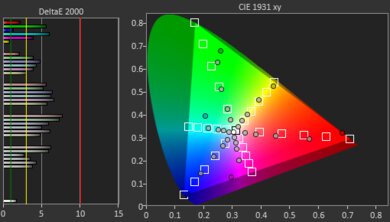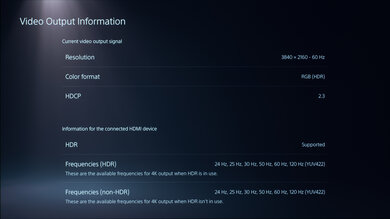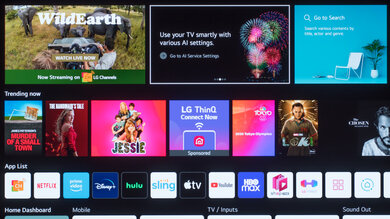The LG B1 OLED is an excellent TV. It sits alongside the LG C1 OLED in LG's 2021 lineup, so it has many of the same features, with a different processor. It's pretty standard for an OLED as it delivers the same exceptional picture quality that they're known for. It can turn off individual pixels, resulting in a near-infinite contrast ratio and perfect black uniformity, making it a fantastic choice for use in dark rooms. Gamers should appreciate the variable refresh rate (VRR) support and HDMI 2.1 inputs, meaning that you can use the next-gen consoles to their full capabilities. Like most OLEDs, it doesn't get very bright, so it's not the best choice for well-lit rooms, but it still has incredible reflection handling. Unfortunately, OLEDs may be the victim of permanent burn-in, but we don't expect this to be an issue for people who watch varied content.
Note: LG USA labels it as 'Online Exclusive', so you can only get it directly from their website in the United States. It seems to be available at other retailers in Europe.
Our Verdict
The LG B1 OLED is an excellent TV overall. It performs best for watching movies in dark rooms because it has a near-infinite contrast ratio with perfect blacks. It's fantastic for gaming as it has VRR support, HDMI 2.1 inputs, and a near-instantaneous response time. It's also great for watching TV shows in a wide seating arrangement, but it doesn't get bright enough to combat glare. However, it risks permanent burn-in, which could be an issue if you constantly watch the same channel with static elements.
- Perfect black levels.
- No blooming around bright objects.
- Fast response time results in smooth motion.
- FreeSync, HDMI Forum VRR, and G-SYNC support.
- Risk of permanent burn-in.
- Doesn't get bright in SDR or HDR.
The LG B1 is outstanding for watching movies in dark rooms. It displays perfect blacks thanks to the near-infinite contrast, and it has perfect black uniformity too. It doesn't have any issues upscaling lower-resolution content like from Blu-rays, and it removes 24p judder from any source, which is great for watching movies.
- Perfect black levels.
- No blooming around bright objects.
- Removes 24p judder from any source.
- Low frame rate content stutters.
The LG B1 is great for watching TV shows in well-lit rooms. It has incredible reflection handling, but because it doesn't get very bright, it's not the best if you want to place it opposite a window with direct sunlight. It has wide viewing angles if you watch TV with the entire family. Unfortunately, OLEDs can suffer from permanent burn-in, which could be problematic if you watch channels with a lot of static content.
- Incredible reflection handling.
- Image remains accurate from the sides.
- No issues upscaling lower-resolution content.
- Risk of permanent burn-in.
- Doesn't get bright in SDR or HDR.
The LG B1 is excellent for watching sports in bright environments. Fast-moving players or balls look great because of the near-instantaneous response time. It has wide viewing angles if you want to watch the big game with a large group of people. Although it doesn't get very bright, it still has incredible reflection handling if you want to use it in a room with a few lights around.
- Incredible reflection handling.
- Image remains accurate from the sides.
- No issues upscaling lower-resolution content.
- Fast response time results in smooth motion.
- Risk of permanent burn-in.
- Doesn't get bright in SDR or HDR.
The LG B1 is fantastic for playing video games. It has many gaming features like a 120Hz panel, two HDMI 2.1 inputs, and variable refresh rate support for nearly tear-free gaming. It has low input lag and a quick response time for a responsive gaming experience. It's great for dark room gaming thanks to its near-infinite contrast, and there's no blooming around bright objects.
- Perfect black levels.
- No blooming around bright objects.
- Fast response time results in smooth motion.
- FreeSync, HDMI Forum VRR, and G-SYNC support.
- Risk of permanent burn-in.
The LG B1 OLED is excellent for watching HDR movies. It's fantastic for watching movies in dark rooms because it displays perfect blacks with no blooming around bright objects. It has incredible gradient handling and displays a wide color gamut for HDR content. Unfortunately, its HDR brightness is just okay, and some highlights may not pop the way the creator intended.
- Perfect black levels.
- No blooming around bright objects.
- Removes 24p judder from any source.
- Displays wide color gamut.
- Low frame rate content stutters.
- Doesn't get bright in SDR or HDR.
The LG B1 is fantastic for HDR gaming. It has a few gaming perks like HDMI 2.1 inputs for 4k @ 120Hz gaming and VRR support. Gaming feels responsive thanks to the low input lag, and motion looks great because it has a quick response time. It displays deep blacks for dark room gaming and has a wide color gamut for HDR content, but its HDR brightness is just okay.
- Perfect black levels.
- No blooming around bright objects.
- Fast response time results in smooth motion.
- FreeSync, HDMI Forum VRR, and G-SYNC support.
- Risk of permanent burn-in.
- Doesn't get bright in SDR or HDR.
The LG B1 OLED is excellent to use as a PC monitor. It has low input lag for a responsive desktop experience. The image remains accurate no matter where you sit because it has wide viewing angles. If you want to use it in a well-lit room, it has incredible reflection handling, but it doesn't get bright enough to combat glare. Unfortunately, OLEDs have the risk of permanent burn-in, which could be caused by static displays like taskbars and the UI interface.
- Incredible reflection handling.
- Image remains accurate from the sides.
- Fast response time results in smooth motion.
- Risk of permanent burn-in.
- Doesn't get bright in SDR or HDR.
Changelog
- Updated Jul 08, 2025: We uploaded the latest brightness measurements and uniformity photos for the Accelerated Longevity Test.
- Updated Apr 17, 2025: We uploaded the latest brightness measurements and uniformity photos for the Accelerated Longevity Test.
- Updated Feb 11, 2025: We uploaded the latest brightness measurements and uniformity photos for the Accelerated Longevity Test.
- Updated Nov 20, 2024: We uploaded the latest brightness measurements and uniformity photos for the Accelerated Longevity Test.
Check Price
Differences Between Sizes And Variants
We tested the 55 inch LG B1 (OLED55B1PUB), which also comes in 65 inch and 77 inch models. For the most part, we expect our results to be valid for those models as well. It's only available through LG's website in the United States, but it seems to be available at retailers in Europe. Unfortunately, it's not available in Canada.
| Size | U.S. Model | EU Model | Germany Model |
|---|---|---|---|
| 55" | OLED55B1PUA | OLED55B16LA | OLED55B19LA |
| 65" | OLED65B1PUA | OLED65B16LA | OLED65B19LA |
| 77" | OLED77B1PUA | OLED77B16LA | OLED77B19LA |
If you come across a different type of panel or your LG B1 doesn't correspond to our review, let us know and we'll update the review. Note that some tests like gray uniformity may vary between individual units.
Our unit was manufactured in June 2021, and you can see the label here.
Popular TV Comparisons
The LG B1 OLED is an excellent TV, which is what we've come to expect with OLEDs. It's essentially an updated version of the LG BX OLED with extremely similar performance. Even though it's a step down from the LG C1 OLED and doesn't get as bright, the differences between each are minimal. The one downside is that the B1 appears to be only sold online through LG in the United States, so it's harder to find than the C1, and it's not available in as many sizes. Still, if you can find the B1 for cheaper, it's worth getting.
Also see our recommendations for the best OLED TVs, the best TVs for watching movies, and the best smart TVs.
The LG B1 OLED and the LG CX OLED are two similar TVs. Picture quality is nearly the same on both because they each have a near-infinite contrast, but the CX gets a bit brighter. The CX's VRR can drop below 40Hz, which the B1 can't do because it lacks low frame rate compensation. Because the B1 is a 2021 model and the CX is 2020, the B1 has an updated version of the LG webOS that features a full home page with apps instead of a banner, and it comes with a redesigned remote, but it has the same functionality as the old remote anyways.
The LG B1 OLED is a higher-end TV than the LG A1 OLED, so it performs better overall. They deliver similar exceptional picture quality thanks to their OLED panels, and even though the B1 gets brighter, it's not a significant difference. The B1 uses a different screen finish, so it has better reflection handling. The main differences are with the gaming features because the B1 has a 120Hz panel with VRR support and HDMI 2.1 inputs, delivering a better gaming experience. The A1 is limited to a 60Hz panel with no VRR.
The LG B1 OLED and the LG C1 OLED sit alongside each other in the 2021 LG lineup. They have many of the same features and performance, but they use different processors, which we don't test. The C1 gets brighter, but the difference isn't very noticeable. The C1 also has a wider refresh rate range because it has low frame rate compensation that allows the VRR to drop below 40Hz, which the B1 doesn't have. The B1 has much better gradient handling, so there's less banding in HDR content.
The LG B1 OLED replaces the LG BX OLED, and the two TVs are very similar. The design didn't change, and the performance didn't change by much either. The B1 gets a bit brighter in HDR, but it's not enough to notice. It also has much better gradient handling, meaning that you won't notice as much banding in scenes with similar shades of color. The B1 has an updated version of the LG webOS and a redesigned remote, but they perform the same as the 2020 model.
Test Results

The LG B1 looks nearly identical to the LG BX OLED. It has the same thin panel with a slanted stand and thin borders. The only real difference is the color of the back panel that's a lighter shade of gray.
The top part of the back panel is smooth metal and the bottom where the inputs are is plastic that looks like brushed aluminum. There's a clip that you attach to the back for cable management.
The LG B1 has okay SDR brightness. It's extremely similar to the LG BX OLED, and although the LG C1 OLED is brighter, the differences are minor. It's not bright enough to fight glare in a well-lit room. Also, it gets less bright with large areas of bright colors due to the aggressive Automatic Brightness Limiter (ABL), so sports like hockey or basketball are dimmer. If you want an OLED that gets brighter, then check out the newer version of this TV, the LG B2 OLED.
We tested it after calibration in the 'Expert (dark space, night)' Picture Mode with Adjust Contrast set to '85', OLED Pixel Brightness to '100', Peak Brightness on 'High', and the Color Temperature set to 'Warm 50'. However, calibrating the TV affected the brightness a bit, as you can see our results before calibration here:
- Peak 2% Window: 412 cd/m²
- Peak 10% Window: 416 cd/m²
- Peak 25% Window: 375 cd/m²
- Peak 50% Window: 303 cd/m²
- Peak 100% Window: 151 cd/m²
- Sustained 2% Window: 391 cd/m²
- Sustained 10% Window: 395 cd/m²
- Sustained 25% Window: 354 cd/m²
- Sustained 50% Window: 289 cd/m²
- Sustained 100% Window: 145 cd/m²
We also reached a peak brightness of 452 cd/m² in the 2% window using the original settings but with Adjust Contrast at '100' and Auto Dynamic Contrast set to 'Medium', but this comes at the cost of losing image accuracy.
The LG B1 doesn't have a backlight, but thanks to its near-infinite contrast ratio, it's equivalent to a perfect local dimming feature. There's no blooming around bright objects in dark scenes, and bright white pixels are displayed perfectly even if they're surrounded by black pixels. We still film these videos on the TV, so you can see how it performs and compare it with a TV that has local dimming.
There's no difference in dark scene behavior between the calibrated picture modes and 'Game' mode.
The LG B1's HDR brightness isn't bad. It's an improvement over the LG BX OLED, but it's still not enough to really make highlights stand out in HDR. Small highlights are the brightest, but it quickly gets dimmer with larger highlights. The EOTF follows the target curve perfectly until the slow roll off at its peak brightness, which happens fairly quickly so it loses details in bright scenes.
We tested it in the 'Cinema HDR' Picture Mode with the OLED Pixel Brightness and Adjust Contrast each at '100', Peak Brightness on 'High', and the Color Temperature set to 'Warm 50'.
If you find the image too dim, use the same settings with Auto Dynamic Contrast set to '50', Color Temperature to 'Cold 50', and enable HDR Tone Mapping. This makes the image brighter as you can see in this EOTF, but it rolls off at the same point.
The HDR brightness in Game Mode is nearly the same as outside of it. Any differences are down to margin of error with our testing. We tested it using the same settings as the regular HDR testing but with the 'Game Optimizer' Picture Mode.
The LG B1 OLED has excellent gray uniformity. There's hardly any dirty screen effect in the center, which is great for watching sports. Uniformity is better in near-dark scenes, but as with other OLEDs, there are faint horizontal and vertical lines. However, they're really hard to notice, especially if you're in a well-lit room.
Note: A few owners have reported seeing a grid-like pattern on their TV in uniform scenes. It's usually not noticeable with real content, but this is a manufacturing defect; if you see it on yours, you should exchange it.
The out-of-the-box accuracy is decent. Most colors are only slightly inaccurate, but white balance is off, and the color temperature is on the cold side, giving the image a blue tint. Gamma is good overall, but some scenes are over-brightened. Keep in mind that accuracy can vary between units.
The accuracy after calibration is remarkable. Any inaccuracies to colors and the white balance aren't visible, and the gamma and color temperature are both nearly spot-on with our targets.
You can see our recommended settings here.
The LG B1 OLED displays a really wide color gamut for HDR content. It has near-perfect coverage of the DCI P3 color space and good coverage of the wider Rec. 2020 color space. However, tone mapping is slightly off for both, as some colors like blue and cyan are inaccurate.
The color volume is decent. It displays a wide range of colors thanks to its excellent color gamut. It displays dark colors perfectly due to the near-infinite contrast, but it struggles with brighter colors.
The gradient handling is fantastic, and it's much better than the LG C1 OLED. There's some minor banding in the darker grays and greens, but it's not very noticeable. The Smooth Gradation setting helps smooth out any banding, but it comes at the cost of losing details.
There are some very minor signs of image retention after displaying a high-contrast static image, but it disappears quickly. This varies between units, and it's not the same as the permanent burn-in risk that OLEDs face.
Unfortunately, like all OLED TVs, the LG B1 isn't immune to permanent burn-in. However, we don't expect people who watch varied content to have any issues, but rather it's a problem if there are constant static displays, like if you use it as a PC monitor. There are a few settings to try to reduce the risk, like Pixel Cleaning, Screen Move and Adjust Logo Brightness. You can read about our investigation into this here.
OLEDs have a near-instantaneous response time, so motion looks extremely smooth with minimal blur. There's some overshoot in darker transitions where the luminance overshoots its target. It can cause the moving object to appear over-brightened quickly, and it's distracting with small, bright objects on dark backgrounds. While some people have reported clearly seeing this problem, it's not an issue across every TV, so not everyone will see it.
There's a black frame insertion feature to try to clear up persistence blur. It flickers both at 120Hz and 60Hz, including in Game Mode. It dims the screen, but not as much as the LG BX OLED. Our BFI score is based on the frequencies it flickers at, but not its actual performance.
The LG B1 has a motion interpolation feature, which causes the 'Soap Opera Effect'. Sadly, it doesn't perform that well, as there are artifacts with fast-moving objects and people. You can tell it's trying to work, and it can't keep up.
Due to the fast response time, there's visible stutter with lower-frame rate content because each frame is held on longer. Enabling the motion interpolation feature can help reduce this effect.
The LG B1 OLED removes 24p judder from any source, which is great for watching movies. It also works if you enable the BFI feature at 120Hz, but not at 60Hz.
The LG B1 has a 120Hz panel with native FreeSync and HDMI Forum variable refresh rate (VRR) support, and it's G-SYNC compatible. It doesn't seem to have low frame rate compensation like the LG C1 OLED, so the VRR doesn't work below 40Hz.
The LG B1 OLED has very low input lag in Game Mode. LG released a new Prevent Input Delay setting with their 2021 models, and setting it to 'Boost' slightly improves the input lag for 60Hz content, but it doesn't do much for 120Hz content. We had trouble getting consistent VRR input lag readings, and the TV would sometimes take itself out of Game Mode, so the results above are the most consistent settings, but they're higher than expected. Unfortunately, you can't enable the motion interpolation setting in Game Mode, which explains why the input lag is so high.
The LG B1 displays any common resolution under the HDMI 2.1 bandwidth up to 4k @ 120Hz. It displays chroma 4:4:4 with 1080p and 4k content at 60Hz and with 4k @ 120Hz signals, but it can't display proper 4:4:4 with any 1440p signal or 1080p @ 120Hz.
The LG B1 doesn't have many issues displaying content from either the Xbox Series X or PS5 up to 4k @ 120Hz in HDR. However, unlike the LG G1 OLED, it seems like it hasn't received the firmware update to support 4k @ 120Hz games in Dolby Vision because the Xbox doesn't show it as a supported format. We'll retest the TV if the update becomes available. There's an Auto Low Latency Mode that switches the TV in Game Mode for low input lag when you launch a game from a compatible device.
The HDMI 2.1 inputs have a maximum bandwidth of 40Gbps instead of 48Gbps, but we don't expect this to affect most people.
Unlike the LG C1 OLED, the HDMI 2.1 inputs are back-facing, which could be hard to reach if you wall-mount it.
The LG B1 OLED has eARC support on HDMI 3, allowing you to pass high-quality, uncompressed Dolby Atmos audio to a compatible receiver through a single HDMI connection. Like other LG TVs, it can't pass DTS audio formats.
The LG B1 OLED has a surprisingly good frequency response. It has better bass than most TVs, but you still need a dedicated subwoofer for true rumbling or punch to the bass. It has a well-balanced sound profile and gets loud, but there are compression artifacts at the max volume.
The distortion performance is okay. There's minimal distortion when listening at moderate listening levels, but it's a lot worse at the max volume. However, this depends on the content, and not everyone may hear it.
The LG B1 comes with an updated version of the LG webOS, which has a full page now instead of the banner from past versions. It's user-friendly, and the menu navigation is fairly smooth. We experienced a few bugs during testing where the TV would randomly take itself out of Game Mode.
Unfortunately, there are ads on the home screen and app store, and there aren't any ways to disable them. They're not always there, so we couldn't take photos during testing.
The redesigned Magic Remote has the same functionality as the older version with the point-and-press feature, so you can use it like a Wii remote. There are also more quick-access buttons to popular streaming services and voice assistants. The voice control feature allows you to change inputs, open apps, search for content, and ask for the weather. We were even able to ask it to change the brightness setting, which we couldn't do with other LG models.
































































































